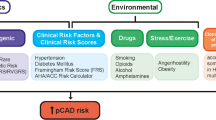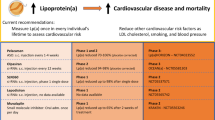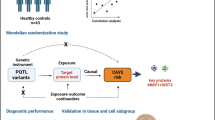Abstract
Objective
The aim of the study was to evaluate the association of miRNA-146a G/C (rs2910164), and miRNA-196a2 C/T (rs11614913) polymorphisms with the presence of coronary artery disease (CAD) and/or restenosis in patients with coronary stent.
Materials and methods
The polymorphisms were determined in 218 patients with CAD who underwent coronary artery stenting (66 with restenosis and 152 without restenosis) and 611 healthy controls using 5′ exonuclease TaqMan assays.
Results
The distribution of both polymorphisms was similar in patients with and without restenosis. However, when the whole group of patients (with and without restenosis) was compared to healthy controls, under co-dominant, dominant and additive genetic models, the T allele of the miRNA-196a2 C/T (rs11614913) polymorphism was associated with increased risk of CAD (OR = 2.18, Pco–dom = 0.006, OR = 1.86, Pdom = 0.002, and OR = 1.52, Padd = 0.002, respectively). All models were adjusted for age, type 2 diabetes mellitus, dyslipidemia, hypertension and smoking habit. The “GT” haplotype was associated with increased risk of developing CAD (OR = 1.36, P = 0.046).
Conclusions
Our data suggests that the T allele of the miRNA-196a2 C/T (rs11614913) polymorphism is associated with the risk of developing CAD, but no association with restenosis was observed.
Similar content being viewed by others
References
Kuchulakanti PK, Chu WW, Torguson R, Ohlmann P, Rha SW, Clavijo LC, Kim SW, Bui A, Gevorkian N, Xue Z, Smith K, Fournadjieva J, Suddath WO, Satler LF, Pichard AD, Kent KM, Waksman R. Correlates and long-term outcomes of angiographically proven stent thrombosis with sirolimus- and paclitaxel-eluting stents. Circulation. 2006;113:1108–13.
Lee SW, Park SW, Kim YH, Yun SC, Park DW, Lee CW, Kang SJ, Park SJ, Lee JH, Choi SW, Seong IW, Lee NH, Cho YH, Shin WY, Lee SJ, Lee SW, Hyon MS, Bang DW, Choi YJ, Kim HS, Lee BK, Lee K, Park HK, Park CB, Lee SG, Kim MK, Park KH, Park WJ, DECLARE-LONG II Study Investigators et al. A randomized, double-blind, multicenter comparison study of triple antiplatelet therapy with dual antiplatelet therapy to reduce restenosis after drug-eluting stent implantation in long coronary lesions results from the DECLARE-LONG II (drug-eluting stenting followed by cilostazol treatment reduces late restenosis in patients with long coronary lesions) trial. J Am Coll Cardiol. 2011;57:1264–70.
Hamasaki S, Tei C. Effect of coronary endothelial function on outcomes in patients undergoing percutaneous coronary intervention. J Cardiol. 2011;57:231–8.
Latib A, Mussardo M, Ielasi A, Tarsia G, Godino C, Al-Lamee R, Chieffo A, Airoldi F, Carlino M, Montorfano M, Colombo A. Long-term outcomes after the percutaneous treatment of drug-eluting stent restenosis. JACC Cardiovasc Interv. 2011;4:155–64.
Costa MA, Simon DI. Molecular basis of restenosis and drug-eluting stents. Circulation. 2005;111:2257–73.
Lee RC, Feinbaum RL, Ambros V. The C. elegans heterochronic gene lin-4 encodes small RNAs with antisense complementarity to lin-14. Cell. 1993;75:843–54.
Ren J, Zhang J, Xu N, Han G, Geng Q, Song J, Li S, Zhao J, Chen H. Signature of circulating MicroRNAs as potential biomarkers in vulnerable coronary artery disease. PLoS One. 2013;8:e80738.
Qin S, Zhang C. microRNAs in vascular disease. J Cardiovasc Pharmacol. 2011;57:8–12.
Fichtlscherer S, De Rosa S, Fox H, Schwietz T, Fischer A, Liebetrau C, Weber M, Hamm CW, Röxe T, Müller-Ardogan M, Bonauer A, Zeiher AM, Dimmeler S. Circulating microRNAs in patients with coronary artery disease. Circ Res. 2010;107:677–84.
Small EM, Frost RJ, Olson EN. MicroRNAs add a new dimension to cardiovascular disease. Circulation. 2010;121:1022–32.
Corsten MF, Dennert R, Jochems S, Kuznetsova T, Devaux Y, Hofstra L, Wagner DR, Staessen JA, Heymans S, Schroen B. Circulating MicroRNA-208b and MicroRNA-499 reflect myocardial damage in cardiovascular disease. Circ Cardiovasc Genet. 2010;3:499–506.
Gomes da Silva AM, Silbiger VN. miRNAs as biomarkers of atrial fibrillation. Biomarkers. 2014;19:631–6.
Gareri C, De Rosa S, Indolfi C. MicroRNAs for restenosis and thrombosis after vascular injury. Circ Res. 2016;118:1170–84.
Santulli G. MicroRNAs distinctively regulate vascular smooth muscle and endothelial cells: functional implications in angiogenesis, atherosclerosis, and in-stent restenosis. Adv Exp Med Biol. 2015;887:53–77.
Wang D, Deuse T, Stubbendorff M, Chernogubova E, Erben RG, Eken SM, Jin H, Li Y, Busch A, Heeger CH, Behnisch B, Reichenspurner H, Robbins RC, Spin JM, Tsao PS, Schrepfer S, Maegdefessel L. Local MicroRNA modulation using a novel anti-miR-21-eluting stent effectively prevents experimental in-stent restenosis. Arterioscler Thromb Vasc Biol. 2015;35:1945–53.
Bartel DP. MicroRNAs: genomics, biogenesis, mechanism, and function. Cell. 2004;116:281–97.
He M, Gong Y, Shi J, Pan Z, Zou H, Sun D, Tu X, Tan X, Li J, Li W, Liu B, Xue J, Sheng L, Xiu C, Yang N, Xue H, Ding X, Yu C, Li Y. Plasma microRNAs as potential noninvasive biomarkers for in-stent restenosis. PLoS One. 2014;9:e112043.
Liu H, Chen M, Wu F, Li F, Yin T, Cheng H, Li W, Liu B, Wang Q, Tao L. rs2910164 polymorphism confers a decreased risk for pulmonary hypertension by compromising the processing of microRNA-146a. Cell Physiol Biochem. 2015;36:1952–60.
Gu JY, Tu L. Investigating the role of polymorphisms in miR-146a, -149, and -196a2 in the development of gastric cancer. Genet Mol Res. 2016;15:027839.
Huang S, Lv Z, Deng Q, Li L, Yang B, Feng J, Wu T, Zhang X, Cheng J. A genetic variant in pre-miR-146a (rs2910164 C/G) is associated with the decreased risk of acute coronary syndrome in a Chinese population. Tohoku J Exp Med. 2015;237:227–33.
Bao MH, Xiao Y, Zhang QS, Luo HQ, Luo J, Zhao J, Li GY, Zeng J, Li JM. Meta-analysis of miR-146a associated with coronary artery diseases and ischemic stroke. Int J Mol Sci. 2015;16:14305–17.
Wang N, Li Y, Zhu LJ, Zhou RM, Jin W, Guo XQ, Wang CM, Chen ZF, Liu W. A functional polymorphism rs11614913 in microRNA-196a2 is associated with an increased risk of colorectal cancer although not with tumor stage and grade. Biomed Rep. 2013;1:737–42.
Buraczynska M, Zukowski P, Wacinski P, Ksiazek K, Zaluska W. Polymorphism in microRNA-196a2 contributes to the risk of cardiovascular disease in type 2 diabetes patients. J Diabetes Complicat. 2014;28:617–20.
Li T, Niu L, Wu L, Gao X, Li M, Liu W, Yang L, Liu D. A functional polymorphism in microRNA-196a2 is associated with increased susceptibility to non-Hodgkin lymphoma. Tumor Biol. 2015;36:3279–84.
Ren YG, Zhuo XM, Cui ZG, Hou G. Effects of common polymorphisms in miR-146a and miR-196a2 on lung cancer susceptibility: a meta-analysis. J Thorac Dis. 2016;8:1297–305.
Xiong XD, Cho M, Cai XP, Cheng J, Jing X, Cen JM, Liu X, Yang XL, Suh Y. A common variant in pre-miR-146 is associated with coronary artery disease risk and its mature miRNA expression. Mutat Res. 2014;761:15–20.
Zhou K, Yue P, Ma F, Yan H, Zhang Y, Wang C, Qiu D, Hua Y, Li Y. Interpreting the various associations of MiRNA polymorphisms with susceptibilities of cardiovascular diseases: current evidence based on a systematic review and meta-analysis. Medicine (Baltimore). 2018;97:e10712.
Wang Y, Wang X, Li Z, Chen L, Zhou L, Li C, Ouyang DS. Two single nucleotide polymorphisms (rs2431697 and rs2910164) of miR-146a are associated with risk of coronary artery disease. Int J Environ Res Public Health. 2017;14:E514.
Bastami M, Ghaderian SM, Omrani MD, Mirfakhraie R, Vakili H, Parsa SA, Nariman-Saleh-Fam Z, Masotti A. MiRNA-related polymorphisms in miR-146a and TCF21 are associated with increased susceptibility to coronary artery disease in an Iranian population. Genet Test Mol Biomark. 2016;20:241–8.
Zhou HY, Wei Q, Shi XD, Cao HY, Qin L. miR-146a rs2910164 polymorphism might be associated with coronary artery disease risk in Asians. Cell Mol Biol (Noisy-le-grand). 2017;63:27–9.
Sung JH, Kim SH, Yang WI, Kim WJ, Moon JY, Kim IJ, Cha DH, Cho SY, Kim JO, Kim KA, Kim OJ, Lim SW, Kim NK. miRNA polymorphisms (miR146a, miR149, miR196a2 and miR499) are associated with the risk of coronary artery disease. Mol Med Rep. 2016;14:2328–42.
Zhi H, Wang L, Ma G, Ye X, Yu X, Zhu Y, Zhang Y, Zhang J, Wang B. Polymorphisms of miRNAs genes are associated with the risk and prognosis of coronary artery disease. Clin Res Cardiol. 2012;101:289–96.
Lahiri DK, Nurnberger JrJI. A rapid non-enzymatic method for the preparation HMW DNA from blood for RFLP studies. Nucleic Acids Res. 1991;19:5444.
Yuan HY, Chiou JJ, Tseng WH, Liu CH, Liu CK, Lin YJ, Wang HH, Yao A, Chen YT, Hsu CN. FASTSNP: an always up-to-date and extendable service for SNP function analysis and prioritization. Nucleic Acids Res. 2006;34(web server issue):W635–41.
Xu Z, Taylor JA. SNPinfo: integrating GWAS and candidate gene information into functional SNP selection for genetic association studies. Nucleic Acids Res. 2009;37(Web Server Issue):W600–05.
Zhou B, Rao L, Peng Y, Wang Y, Chen Y, Song Y, Zhang L. Common genetic polymorphisms in pre-microRNAs were associated with increased risk of dilated cardiomyopathy. Clin Chim Acta. 2010;411:1287–90.
Xu J, Hu Z, Xu ZF, Gu H, Yi L, Cao H, Chen J, Tian T, Liang J, Lin Y, Qiu W, Ma H, Shen H, Chen Y. Functional variant in microRNA-196a2 contributes to the susceptibility of congenital heart disease in a Chinese population. Hum Mutat. 2009;30:1231–6.
Sun R, Liu M, Lu L, Zheng Y, Zhang P. Congenital heart disease: causes, diagnosis, symptoms, and treatments. Cell Biochem Biophys. 2015;72:857–60.
Watkins H, Farrall M. Genetic susceptibility to coronary artery disease: from promise to progress. Nat Rev Genet. 2006;7:163–73.
Toraih EA, Ismail NM, Toraih AA, Hussein MH4, Fawzy MS. Precursor miR-499a variant but not miR-196a2 is associated with rheumatoid arthritis susceptibility in an Egyptian population. Mol Diagn Ther. 2016;20:279–95.
Fragoso Lona JM, Sierra Martínez M, Vargas Alarcón G, Barrios Rodas A, Ramírez Bello J. Tumor necrosis factor alfa in cardiovascular diseases: molecular biology and genetics. Gac Med Mex. 2013;149:521–30.
Luthra R, Singh RR, Luthra MG, Li YX, Hannah C, Romans AM, Barkoh BA, Chen SS, Ensor J, Maru DM, Broaddus RR, Rashid A, Albarracin CT. MicroRNA-196a2 targets annexin A1: a microRNA mediated mechanism of annexin A1 downregulation in cancers. Oncogene. 2008;27:6667–78.
Acknowledgements
This work was supported in part by grants from the Consejo Nacional de Ciencia y Tecnología (Project number 233277), Mexico City, Mexico. The authors are grateful to the study participants. Institutional Review Board approval was obtained for all sample collections. The authors are grateful to Marva Ilian Arellano Gonzalez for her technical assistance.
Author information
Authors and Affiliations
Corresponding author
Ethics declarations
Conflict of interest
The authors report no conflicts of interest. The authors alone are responsible for the content and writing of the paper.
Additional information
Responsible Editor: Andrew Roberts.
Publisher’s Note
Springer Nature remains neutral with regard to jurisdictional claims in published maps and institutional affiliations.
Rights and permissions
About this article
Cite this article
Fragoso, J.M., Ramírez-Bello, J., Martínez-Ríos, M.A. et al. miR-196a2 (rs11614913) polymorphism is associated with coronary artery disease, but not with in-stent coronary restenosis. Inflamm. Res. 68, 215–221 (2019). https://doi.org/10.1007/s00011-018-1206-z
Received:
Revised:
Accepted:
Published:
Issue Date:
DOI: https://doi.org/10.1007/s00011-018-1206-z




